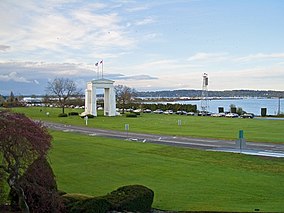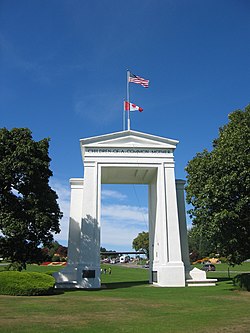| Peace Arch Park | |
|---|---|
 Peace Arch Park, seen from the Canadian side Peace Arch Park, seen from the Canadian side | |
| Location | Canada and United States |
| Nearest city | Blaine, Washington/Surrey, British Columbia |
| Coordinates | 49°00′07.5″N 122°45′24″W / 49.002083°N 122.75667°W / 49.002083; -122.75667 |
| Area | Canada: 22 acres (8.9 ha) U.S.: 20 acres (8.1 ha) |
| Established | November 7, 1939 |
| Governing body | Canada: BC Parks U.S.: Washington State Parks |
| Peace Arch | |
|---|---|
 The Peace Arch from the U.S. side. The Peace Arch from the U.S. side. | |
| Height | 67 feet (20 m) |
| Built | 1921 |
| Architect | Harvey Wiley Corbett |
| Architectural style(s) | Classical Revival |
| U.S. National Register of Historic Places | |
| Designated | December 13, 1996 |
| Reference no. | 96001493 |


Peace Arch Park is an international park consisting of Peace Arch Historical State Park in Washington, United States and Peace Arch Provincial Park in British Columbia, Canada. The park straddles the international boundary between the two countries at the extreme western end of the main contiguous section of the two countries' land border, between Blaine, Washington, United States, and Surrey, British Columbia, Canada, where it reaches Semiahmoo Bay of the Salish Sea on the continent's Pacific Coast.
The park's central feature is the Peace Arch (French: Arche de la Paix). Construction of the 20.5-meter (67 ft) tall arch was headed by American lawyer Sam Hill and dedicated in September 1921. The Peace Arch commemorates the signing of the Treaty of Ghent in 1814 and symbolizes a long history of peace between the two nations. The monument is built on the exact U.S.–Canada boundary, where Interstate 5 on the U.S. side of the border becomes Highway 99 on the Canadian side, in the grass median between the northbound and southbound lanes.
The park is located at the Peace Arch Border Crossing (also known as the Blaine–Douglas Border Crossing), where Highway 99 in British Columbia and Interstate 5 in Washington State meet. It is one of the busiest border crossings between Canada and the United States, and the busiest such crossing west of Detroit. The park's northern portion is about 9 hectares (22 acres) and is managed by the British Columbia Ministry of Environment. The southern portion is about 20 acres (8.1 ha) and is managed by the Washington State Parks and Recreation Commission.
About 500,000 people visit the Peace Arch each year. The monument and surrounding park is considered an international park. As such, visitors do not require either a passport or visa to pass through their applicable border crossing so long as they stay within the boundaries of the park and leave the park into the country from which they entered the park.
History and description
Border inspection services at what is now known as the Peace Arch Border Crossing long predated the 1921 construction of the Peace Arch.
In 1914 Samuel Hill, lawyer for the Great Northern Railway, organized an international fundraising campaign to build the Peace Arch. American architect Harvey Wiley Corbett donated his talents to design the Arch. International volunteers began constructing in 1920. It was dedicated on September 6, 1921, and was considered one of the first earthquake-resistant structures built in North America.
It commemorates the Treaty of Ghent and the Rush-Bagot agreement ending the War of 1812, which "provided for peaceful resolution of U.S.—British disputes and an unguarded U.S./Canadian border." The United States side was established as a state park in 1931. The Canadian side was established as a provincial park on November 7, 1939.
The Peace Arch has the flags of United States and Canada mounted on its crown, and two inscriptions on both sides of its frieze. The inscription on the U.S. side of the Peace Arch reads "Children of a common mother" (referring to the two nations' common origin from the British Empire), and the words on the Canadian side read "Brethren dwelling together in unity" (Psalm 133:1). Within the arch, each side has an iron gate mounted on either side of the border with an inscription above each gate: the one on the east side read "May these gates never be closed", while on the west side read "1814 Open One Hundred Years 1914".
The Peace Arch Park has been the site of various international events and protests. In 1952, African-American singer and activist Paul Robeson, banned from international travel during the Red Scares, performed several concerts at the site. He sang from a flatbed truck on the American side to an audience in Canada. The Peace Arch was vandalized with paint and other damage by Canadian protestors demonstrating against the Cambodian campaign during the Vietnam War on May 9, 1970.
The Arch was added to the Canadian Register of Historic Places in 1939, and to the U.S. National Register of Historic Places in 1996.
On February 9, 2010, the Vancouver 2010 Olympic Torch Relay visited the north side of the Peace Arch, while Premier Gordon Campbell and Governor Christine Gregoire addressed a crowd of several hundred people.
COVID-19 pandemic
In response to the COVID-19 pandemic, the Canada–United States border was shut down for non-essential travel on March 21, 2020. Initially, the parks on both sides of the border continued to open, allowing visitors from both sides of the border to gather at the park. However, as the number of park visitors continued to increase, the Canadian side of the park was ordered to close on June 18, 2020. On November 8, 2021, the border reopened to non-essential travel for Canadians who received a COVID-19 vaccine.
Despite the closure of the Canadian side of the park, and to get around mandatory Canadian public health and quarantine requirements, some visitors on the Canadian side continued to cross the border by directly accessing Peace Arch Historical State Park from 0 Avenue in Surrey. Although the U.S. Customs and Border Protection allowed Canadian visitors to enter the American side of the park and return to Canada, Canada Border Services Agency required anyone crossing the international border to report to CBSA to avoid potential penalties or charges. In an interview with CBC News, an immigration attorney from Washington state cited that the 1814 Treaty of Ghent prevents the erection of a barrier on the boundary, as it stipulates that such an action would cause the entire US-Canada boundary governed by the treaty to revert to its pre-treaty status.
Peace Arch Park is one of the most common locations reported to have served for 2020–21 border weddings. Unlike other border crossings where weddings were held, Peace Arch allowed both sides to meet in the same location with no separation.
Recreation
Recreational activities include walking and picnicking as well as a playground for children. Visitors are allowed to explore both sides of the Canada–United States border inside the park, but are warned not to cross the boundary of the park to enter the adjacent country without being cleared to enter by the respective customs authority, as violators are subject to prosecution. Although no known cameras are in the park itself, United States Border Patrol agents in cars, on bikes, and on foot inside and steerable cameras on poles outside watch the park.
Events
The International Peace Arch Association (IPAA) (formerly the United States Canada Peace Anniversary Association) is a nonprofit association dedicated to the heritage and preservation of the international monument. The association hosts park events and activities including the annual International Sculpture Exhibition, which highlights the work of American and Canadian artists.
See also
References
- ^ "National Register Information System". National Register of Historic Places. National Park Service. January 23, 2007.
- There is a detached section of the land border a few kilometers (miles) west on the Point Roberts peninsula.
- ^ "Peace Arch Provincial Park". BC Parks. British Columbia Ministry of Environment. Retrieved March 21, 2016.
- ^ "Peace Arch Historical State Park". Washington State Parks and Recreation Commission. Retrieved March 21, 2016.
- "Peace Arch – City of Surrey Heritage Sites". www.surrey.ca. Retrieved December 31, 2016.
- About Peace Arch Park Archived September 4, 2012, at the Wayback Machine
- "Custom Entry Ports in Surrey". Retrieved December 6, 2014.
- "Peace Arch – City of Surrey Heritage Sites". www.surrey.ca. Retrieved December 31, 2016.
- Dougherty, Phil (August 2, 2007). "About 450 Canadians invade Blaine on May 9, 1970". HistoryLink. Retrieved December 8, 2022.
- "HistoricPlaces.ca - HistoricPlaces.ca". www.historicplaces.ca. Retrieved September 8, 2024.
- Broom, Jack (February 9, 2010). "Early risers gather for glimpse of Olympic Torch". The Seattle Times. Retrieved January 29, 2024.
- "Order of the Executive Director" (PDF). Province of British Columbia. June 1, 2020. Retrieved January 5, 2021.
- Schmunk, Rhianna. "B.C. closing Peace Arch park at Canada-U.S. border due to 'significant' number of visitors". CBC.
- "Prime Minister announces temporary border agreement with the United States". Prime Minister of Canada. March 21, 2020. Retrieved December 7, 2021.
- Mackrael, Paul Vieira and Kim (November 30, 2021). "U.S.-Canada Border Reopened on Nov. 8: What to Know About Travel". Wall Street Journal. ISSN 0099-9660. Retrieved December 7, 2021.
- Miljure, Ben (November 12, 2020). "People still taking advantage of cross-border B.C. park to skip quarantine". CTV News.
- ^ Robinson, Matt. "Officials say border loophole hangout spot 'concerning,' warn of penalties". Vancouver Sun.
- Yvette Brend (July 2, 2020). "Cross-border mingling near Peace Arch still a walk in the park, says lawyer from Washington state". CBC News.
- Little, Simon (September 9, 2020). "Frequent weddings in cross-border Peace Arch Park spur COVID-19 concerns". Global News.
- Little, Simon (June 6, 2020). "Canada-U.S. couple ties the knot at B.C.'s border-straddling Peace Arch Park". Global News.
- ^ "International Peace Arch Association (IPAA)". Archived from the original on October 23, 2016. Retrieved August 8, 2018.
- "Chapter 6: Washington State". United Divide: A Linear Portrait of the USA/Canada Border. The Center for Land Use Interpretation. Winter 2015.

Further reading
- Clark, Richard (2005). Sam Hill's Peace Arch: Remembrance of Dreams Past. Bloomington, Ind.: AuthorHouse. ISBN 1-4208-5168-3.
External links
- International Peace Arch Association
- Peace Arch Provincial Park BC Parks
- Peace Arch Historical State Park Washington State Parks and Recreation Commission
- "Peace Arch Park". BC Geographical Names.
| Protected areas of Washington | |||||||||||||||||||||||||
|---|---|---|---|---|---|---|---|---|---|---|---|---|---|---|---|---|---|---|---|---|---|---|---|---|---|
| Federal |
| ||||||||||||||||||||||||
| State |
| ||||||||||||||||||||||||
| Other |
| ||||||||||||||||||||||||
|
| |||||||||||||||||||||||||
- Canada–United States border
- Peace parks
- Parks in Surrey, British Columbia
- Parks in Whatcom County, Washington
- State parks of Washington (state)
- Monuments and memorials in Washington (state)
- Provincial parks of British Columbia
- Transboundary protected areas
- 1939 establishments in British Columbia
- Protected areas established in 1939
- 1939 establishments in Washington (state)
- Interstate 5